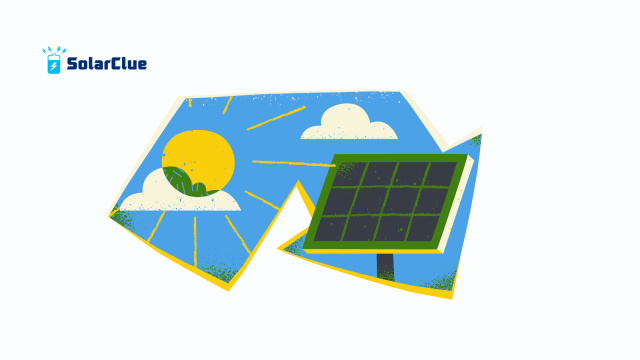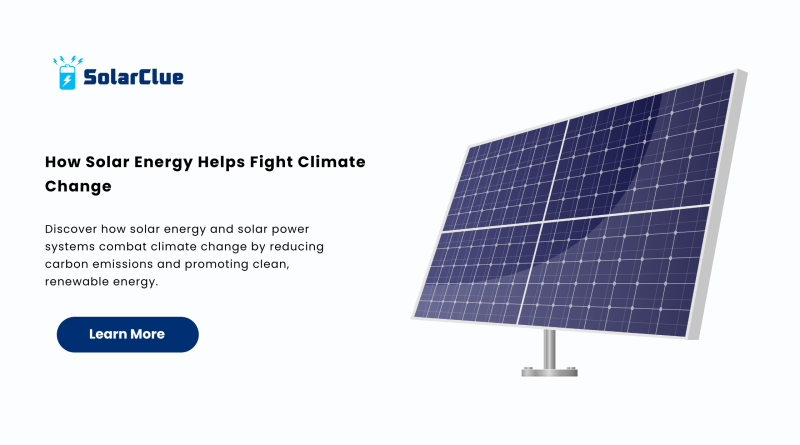How Solar Energy Helps Fight Climate Change
The growing threat of climate change is no longer a distant reality—it’s happening right now. From melting glaciers to rising sea levels and extreme weather patterns, the impacts are visible worldwide. As the world seeks sustainable solutions, solar energy has emerged as a leading force in the fight against climate change. It offers a clean, abundant, and accessible alternative to fossil fuels, helping reduce our dependence on polluting energy sources.
Table of Contents
- 1 What is Solar Energy?
- 2 The Link Between Fossil Fuels and Climate Change
- 3 How Solar Energy Reduces Carbon Emissions
- 4 Benefits of Solar Energy for the Environment
- 5 Technological Advances in Solar Power
- 6 Economic Advantages of Solar Energy
- 7 Solar Power in India: A Growing Force
- 8 The Role of Residential Solar Power Systems
- 9 Commercial and Industrial Solar Applications
- 10 Solar Energy Storage and Grid Stability
- 11 Government Policies and Incentives
- 12 Solar and Sustainable Urban Planning
- 13 Long-Term Impact on Climate Goals
- 14 Overcoming Challenges in Solar Adoption
- 15 The Future of Solar Energy
- 16 Conclusion
- 17 FAQs
What is Solar Energy?
Solar energy is the power harnessed from the sun’s rays. Using technologies like solar panels and solar power systems, we can convert sunlight into electricity or thermal energy. It’s a form of renewable energy, meaning it replenishes naturally and doesn’t run out, unlike coal, oil, or natural gas.
The Link Between Fossil Fuels and Climate Change
Burning fossil fuels releases greenhouse gases such as carbon dioxide (CO2) into the atmosphere. These gases trap heat and contribute to global warming. About 75% of global greenhouse gas emissions come from energy production, and reducing this is essential. Transitioning to solar power is a strategic way to lower emissions and limit global temperature rise.
How Solar Energy Reduces Carbon Emissions
By using solar power systems, we can generate electricity without producing CO2. Every kilowatt-hour of solar energy used in place of fossil fuel-based electricity saves roughly 1.5 pounds of CO2. On a large scale, this has the potential to reduce billions of tons of emissions annually.
Benefits of Solar Energy for the Environment
- Reduces Air and Water Pollution: Unlike coal or nuclear plants, solar panels don’t emit harmful pollutants or require vast amounts of water.
- Slows Global Warming: By replacing fossil fuels, solar energy mitigates the effects of climate change.
- Preserves Natural Resources: Solar power systems don’t rely on extracting or burning limited natural resources.
Technological Advances in Solar Power
Innovations in solar panel efficiency, battery storage, and smart grid systems are making solar power more accessible and effective. Emerging trends like bifacial panels, perovskite cells, and AI-powered tracking systems have enhanced energy capture and system reliability.
Economic Advantages of Solar Energy
Beyond the environmental benefits, solar energy also offers economic incentives:
- Lower Electricity Bills
- Job Creation in the Renewable Sector
- Energy Independence for Households and Nations
Countries investing in solar power systems are not only protecting the planet but also boosting economic resilience.
Solar Power in India: A Growing Force
India is witnessing a solar revolution. With vast sunlight availability and government support through schemes like PM-KUSUM and solar subsidies, the adoption of solar panels and solar power systems is soaring. Platforms like SolarClue are playing a crucial role by offering reliable solar products and services.
The Role of Residential Solar Power Systems
Homeowners are increasingly installing solar panels to power their homes. A standard residential solar power system reduces household emissions significantly, while also slashing electricity costs. Rooftop solar installations are easy to set up and maintain, offering long-term returns.
Commercial and Industrial Solar Applications

Large-scale operations like factories, offices, and schools are integrating solar energy to cut energy expenses and reduce their carbon footprint. Industrial solar power systems often pay for themselves within a few years, thanks to energy savings and incentives.
Solar Energy Storage and Grid Stability
Batteries and energy storage systems allow solar power to be used even during cloudy days or at night. This helps stabilize the power grid and ensures a consistent energy supply. Innovations in lithium-ion and flow batteries are improving storage capacity and efficiency.
Government Policies and Incentives
Government support is crucial to scaling solar power. Policies such as tax credits, net metering, and feed-in tariffs have made solar more attractive to consumers. In India, MNRE’s rooftop solar program provides direct subsidies to reduce initial costs.
Solar and Sustainable Urban Planning
Cities around the world are incorporating solar energy into their infrastructure. From solar panels on rooftops to solar-powered streetlights and transit systems, urban areas are embracing clean, renewable energy to combat urban pollution and heat islands.
Long-Term Impact on Climate Goals
Solar energy is central to achieving global climate targets such as the Paris Agreement. With scalable technology and dropping costs, solar is uniquely positioned to replace fossil fuels in both developed and developing nations.
Overcoming Challenges in Solar Adoption
While solar energy is promising, challenges remain. These include:
- High upfront costs (though falling)
- Limited awareness in rural areas
- Need for better grid integration Solutions involve policy reforms, education, and investment in infrastructure.
The Future of Solar Energy
The future of solar power looks bright—literally and figuratively. With ongoing R&D, supportive policies, and rising public awareness, solar will continue to be a cornerstone in the climate fight. Adopting solar power systems is no longer just a trend—it’s a necessity for a livable future.
For in-depth insights and the latest solar products, visit blog.solarclue.com.
Conclusion
Fighting climate change demands urgent, collective action—and solar energy is one of the most powerful tools we have. It’s clean, cost-effective, and scalable. Whether you’re a homeowner, a business owner, or a policymaker, embracing solar power systems contributes directly to a healthier planet. Let’s choose the sun, and choose sustainability.
Explore more at SolarClue.com and be part of the solution.
FAQs
1. How does solar energy help reduce climate change?
By replacing fossil fuels, solar energy cuts greenhouse gas emissions, reducing global warming.
2. Can solar panels work during cloudy weather?
Yes, solar panels can still produce energy under diffused sunlight, though efficiency may drop slightly.
3. Is solar power cost-effective?
Absolutely. While the upfront investment can be high, long-term savings on electricity bills make solar power systems economically viable.
4. What are the government incentives for solar in India?
India offers subsidies for rooftop solar panels, net metering, and other tax benefits through MNRE and state-level schemes.
5. How long do solar panels last?
Most solar panels come with a warranty of 25 years and can function efficiently even longer with minimal maintenance.




